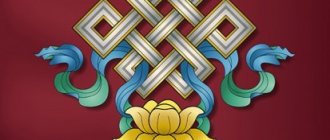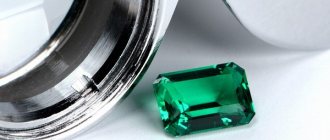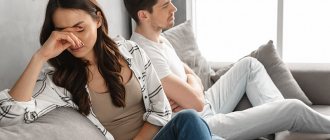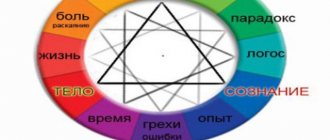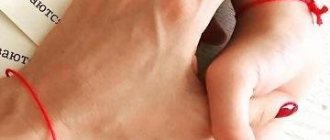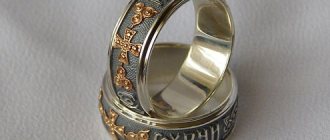The name “Celtic” was given to those types of knots and stylized designs that served a decorative function among the ancient Celts. Mostly church monuments with manuscripts were painted with Celtic knots. Notable examples include the Book of Kells, the 8th-century Lichfield Gospel and the Lindisfarne Gospel. It was from that time that their spread began across different countries and cultures of the world.
The earliest interlocking patterns first appeared during the Roman Empire. And by the 3-4th century, a special form of art was formed from knotted ornaments, which was soon embodied in the form of decorating mosaic floors. Celtic patterns were very popular in the architecture of Ancient Byzantium, as well as in the art of the Celts, Copts and Islamists.
What is a Celtic knot?
Celtic weaving, also known as the Celtic knot, is a decorative applied art that is generally believed to have developed under the influence of Christianity. In ancient times, this very weaving was used to decorate the Bible.
In addition, Celtic knots were used to form memorial crosses and precious jewelry. There is a theory that wooden objects and textiles were decorated in this way, but too few examples have survived to this day to be able to say with confidence how widespread such a tradition was.
History of the Celtic Knot
Irish sacred books survive from the seventh century AD. They were already decorated with a Celtic knot. It is believed that the ornament was invented even earlier by Coptic monks, who, in turn, brought its idea from either Syria or Egypt. In any case, the knot passed from the Copts to the Anglo-Saxons, who spread the images throughout Ireland.
Coptic knots, considered the ancestors of Celtic knots, attract attention because of their consistency. They differ from Roman knots and German weaving in the absence of freely hanging ends.
The beauty that conquered the world
Ireland was not the only place where the Celtic knot was widespread; its significance for the cultures of neighboring areas is also great. Weaving quickly gained popularity in Wales and Scotland, and also found its way to Northumbria.
Thanks to the monks of the Celtic Church, especially missionaries traveling to different countries, weaving spread to European countries. The style was adopted some time later by the Vikings. It was from the Celtic knot that the “animal style” so characteristic of the Vikings arose.
Development of the idea of Celtic knots
Over time, images of a variety of animals, mostly fantastic, began to be woven into Celtic knots. This happened under the influence of the cultures of the Picts and Saxons. When the craftsmen and artists of past centuries were able to combine the complexity of knots and the phantasmagoria of imaginary animals, they formed what later became known as “Insular Art” - a unique style of jewelry making and surface decoration, unmatched in both complexity and beauty.
An important law that applies to all Celtic knots: no artist doing work in this genre will leave loose ends hanging. It will either be a spiral, because it is stylized to resemble a part of an animal’s body. A pure knot in Celtic art is infinity in its material embodiment. This is the basic idea of art.
Around the 8th century AD, the Book of Kells was written. To this day, it is the most important source of information about the traditions and patterns of Celtic knots. The book also tells about the various decorative ornaments common among the Celts. The paintings collected in the Book of Kells are incomparable in their beauty to any other applied art.
Giraldus of Cambria, a scientist who lived in the 13th century, stated: The Book of Kells is a gift to people from angels. Much later, the famous modern author Umberto Eco expressed the opinion that the Book of Kells is nothing more than the fruit of hallucinations.
Recent decades have been characterized by a surge of interest in Celtic culture in general and the arts and crafts in particular. Of course, Celtic knots immediately came out on top. True, the samples that are created these days are nothing more than copies of truly real historical works. However, there are several artists who have approached the issue thoroughly - guided by information about previous technologies that have survived to this day, they create more and more new patterns, complex, striking the imagination with their beauty.
Symbolic
The Celtic protection knot, the meaning of which in fact does not have an unambiguous generally accepted interpretation, nevertheless represents one of the most ancient ornaments of the northern tradition. And although the pattern, which today we call the “protection knot,” was used not only by the Celts, its semantics is usually sought in the culture of this particular people.
The Celts themselves used the “knot of protection” symbol everywhere: it was applied to shields, and similar ornaments were also used in the process of making clothes and building dwellings. In this case, it is important to understand that the Celtic “knot of protection” is not a purely sacred sign. Undoubtedly, this symbol had, let’s say, a special esoteric functionality, but in this case we are talking about ornamentalism, that is, the applied, everyday aspect comes to the fore.
Unfortunately, the Celts did not leave any information that could shed light on the symbolism of this sign. The protection knot, the meaning of which to a certain extent is rightly sought in its name, was clearly a universal symbol. Archaeological finds dating back to the first centuries BC, historical evidence (in particular Roman) and later pictorial sources indicate that the Celtic protection knot was actually used as an ornamental element in everyday life: along with other “knots” it was applied to clothing , it is often found on utensils and jewelry. An important point: there are no specific talismans or single products with the image of a Celtic knot, so any use of this sign in the form of a single amulet is in no way a reconstruction, let’s say, a variation on a theme.
At the same time, it is known that the Celts put a protection knot on their shields, and there is also a mention of tattoos that contain elements reminiscent of a protection knot. The meaning of this symbol for the Celts was of great importance. If such a sign was applied to military paraphernalia and the bodies of warriors, it means that we are talking about some kind of image into which people invested, if not protective, then at least powerful life-affirming promises. The Celts were skilled warriors; their state formations collapsed for a number of reasons, but definitely not due to poor combat training. However, their culture has reached us and many Celtic traditions are preserved in the British Isles in virtually unchanged form.
It is important to note one more point: the Celtic knot of protection (its meaning, by the way, could change over time) was also known to the Scandinavians. The legendary sailors and fierce warriors, the Vikings, also used this sign, but in a somewhat interpreted form. The original Celtic protection knot is a slightly more complex design than the pattern commonly called the "Viking protection knot". Obviously, the Vikings, like the Celts, did not leave any “practical manuals” on their esoteric system, except perhaps the Edda, but in this case this source is useless. The Viking protection knot is found on numerous rune stones, literally “scattered” throughout the European north. In addition, the same symbol, the Viking protection knot, was applied by the stern northern fighters, just like the Celts, to their shields and, probably, to their bodies. As for tattoos, the question is, of course, controversial, because the only documentary source describing Viking tattoos (the works of Ibn Fadlan) does not say anything specific about the symbol that interests us. However, this is more than likely.
It is also curious that there is no clear definition of the etymology of the concept “Celtic knot of protection”. Actually, “Celtic knots” are the name given to the characteristic patterns that were used in the ornaments (domestic and specialized) of this people. The very concept of “protection” in this case is also not a canon, but a purely subjective definition. Probably, the key role here was played by the fact that the sought-after “knot” was applied to shields by the Celts and Vikings.
One way or another, the semantic definition of the Celtic knot of protection is lost over the centuries. It is obvious that the Viking protection knot, the meaning of which is apparently similar to the semantics of the Celtic image, is in many ways a military symbol. Hence the image of protection. On the other hand, both peoples used this sign in everyday life. Actually, this is not surprising, because, for example, the Slavs used swastikas everywhere - they put them on shields, on weapons, on household items, and on clothes. Probably, the Celtic protection knot (also known as the Viking protection knot in context) really had powerful positive, and most importantly, universal symbolism. And here we again touch upon the great wisdom of our distant ancestors, who left us their messages, wordless, but no less vivid. Particularly bright for those who are able to read them.
Subtleties of Celtic knot meanings
Nowadays, the issue of the symbolism of the Celtic knot has become very complex. It is difficult to determine what the real significance is - this requires serious archaeological research. Probably, a lot can be learned from those church books that were customarily decorated with Celtic knots. There is an assumption that the continuity of the loop is a reference to eternity. All elements of the product are dependent on one another and, probably, this also refers to the ideology of Christianity: help your neighbor.
Another theory says that Celtic knots were woven to protect against evil forces and spirits from the other world. When human figures or silhouettes of phantasmagoric creatures were woven into the knots, this was probably supposed to reflect the interconnection of all living things. If two or more knots were woven, this reflected the connection between the divine and the human.
Sometimes knots were woven to forever tie two people in love, and special motifs were made for hunters so that they would return only with prey. Of course, there were Celtic amulets. These were believed to be very powerful amulets. Needless to say, to this day many sincerely believe in this.
If you study modern editions of the New Testament, you will notice: here and there there are pictures of supposedly Celtic knots. You should not pay much attention to them; such samples do not carry any meaning. These are just decorative elements.
The Celts remain in the distant past, and this makes it difficult to understand their art. Today, only archaeologists and symbolic scientists can unravel the symbolism of knots. Those Celtic symbols that have survived to this day are interpreted by people completely differently, not in the same way as the ancient people themselves perceived them. This is not surprising, because the realities of life have undergone significant changes.
Celtic tattoos on the arm, shoulder and other parts of the body
As you know, the Celts are a brave, warlike and freedom-loving people. All these qualities are considered primordially masculine, which is why Celtic tattoos are especially attractive to men. Anyone looking to get a Celtic tribal tattoo wonders where the image will look best. Experts believe that Celtic tattoos appear on the following areas of the body:
- Back.
- Breast.
- Shoulder.
- Hand.
- Belly (preferable for girls).
Meanings: general rule
A general rule has been developed to help understand the meaning of Celtic knots. It cannot be said that it works in 100% of cases, however, it almost always works, especially if the knot is relatively simple.
The shape of the picture is what first of all lifts the veil of secrecy and explains the Celtic symbols. If some animal is woven into the knot, this means that the creator wanted to convey a trait, a sign that is most characteristic of this creature.
The circle in the Celtic knot is intended to represent the idea of unity and eternity. Rebirth and the endless cycle of life are depicted as a spiral. To depict the sea, the greatness of heaven and earth in a knot, the Celts resorted to triangles and trefoils. The protective functions were carried out by square and rectangular elements of the pattern. To reflect the close relationship between nature and man, figures of people and animals were woven.
Labyrinth and cross
Gradually, the Celtic knot improved and moved from the realm of ceremonial fine art of priests into the life of ordinary people.
Amulets carved from wood and woven amulets made from strips of leather appeared. This stage is characterized by the presence of transitional features to Christianity. At this time, a foreign religion, together with the Roman legions, approached the threshold of the Celts in the north of modern France and in Britain.
New symbols depicted the spiritual quest, the centrifugal force of energies and the path of life. In particular, these include the classic labyrinth. It is this that has this meaning. The Celtic knot consisted of many plexuses, but all its threads led exclusively to the center of the composition.
With the advent of Christianity, this symbol is slightly transformed and takes the form of a cross. The famous Celtic crosshairs in a circle came from the first labyrinths. Often its ends expand outward, which symbolized the infinity of spiritual development with the interconnection of the spiritual and worldly, as well as the feminine and masculine principles.
What is a Celtic amulet knot?
The most famous amulet based on the Celtic knot is the Taliesin knot. It received its name from the name of a bard who lived in the 6th century and was known for his prophetic abilities. Taliesin was a druid, and therefore the knot named after him helps to reveal talents and abilities for mysticism, and also protects against black magic, hostile witchcraft and demons. A talisman depicting Celtic symbols will help you discover the truth, cope with your fears and find the path to omniscience.
The Big Knot is also known. Such an amulet was supposed to protect a person. The influence of the amulet is strongest in interpersonal relationships, and only good ones. The Celtic knot is very different from the Gordian knot, since it is impossible to cut, much less untie, the weaving. It is equally impossible to comprehend infinity or to dominate eternity. But the amulet based on the Celtic knot shows that you can forever connect yourself with infinity.
The main purpose of an amulet with a Celtic knot is protection from unpleasant events. The amulet protects from difficulties and helps to overcome obstacles; it can help cope with an illness or enhance certain personality traits of its owner. A Celtic knot made from cord is usually made by an expert in knot magic, a sorcerer or a healer. Sometimes a person weaves Celtic knots for amulets for himself.
When creating a knot amulet, you need to correctly program it to help yourself, subjugate it and put a piece of yourself, your will, into the amulet. Only then will it work. You cannot give an amulet knot as a gift, but you can inherit it. If you really want to give such a gift, you can give a blank, which the person can then customize for himself. However, if you give a ready-made amulet, it can become a talisman for good luck.
Tattoos
Who is not fascinated by the Celtic knot with its endless plexuses? Many fans of extreme jewelry would not mind seeing a tattoo with such an ornamental masterpiece on their body.
What do these or those images mean? Let's take a closer look. Oddly enough, in this area of tattooing there are no hidden elements or coded images, as, for example, in the criminal world. Each Celtic pattern reflects one idea, no matter how it was created.
A spiral on a weapon or armor, the wall of a house or the owner’s shoulder always signifies only growth and development. So, three similar figures symbolize only improvement in three planes. Today esotericists call them physical, astral and mental.
Labyrinths, which are the most popular ornaments, depict a person's life path. The Celts did not believe in final death, so all the patterns are endless, the movement in them goes in a circle.
Thus, today we have become acquainted with the unique culture of the ancient Western European people. Today, during a period of special fascination with the mysterious and sacred, this information will be of interest to many.
What is a Celtic Love Knot?
The Celtic love knot is an amulet that people have trusted with their deepest feelings for many centuries. This talisman is a symbol of the unity of two hearts. It has become widespread in different cultures, and today the Celtic love knot can be found almost all over the world. Endless hopes, the interweaving of feelings and faith, the confidence that love will never end - all this is embodied in the endless Celtic love knot. It helps two lovers link their lives forever; it can become an oath of fidelity for them.
Knots were very important in Celtic magic, and the love knot was especially highly valued. Its use in love magic was characteristic not only of the Druids of the 6th-8th centuries, it has survived to this day. A powerful egregor still has power today, because people’s ability to love has not decreased.
A closed knot of love has no end or beginning, symbolizing the fact that love is changeable, diverse, it changes smoothly and changes people, connecting them with each other. The essence of the Celtic love knot is to create the most favorable situation for two soul mates. Two people decide their destiny, create a path in life, guided not only by their passions, but also by God’s providence, and the harmony and symmetry of the love amulet helps them in this. Smooth Celtic weaving excludes any manifestation of destructive chaos.
Exchange a Celtic love knot - imprint your feelings on heavenly tablets. This ritual is no less important than, say, the exchange of wedding rings.
Magic Agishjalm
Many people have already become convinced of the magic of Agishjalm. The cross of invincibility and many other magical objects are also popular, which can easily help a person solve significant life problems, find happiness, self-confidence, love, and financial well-being. The most important thing is to understand all four elements; choose the one that will personify the person.
During the period of their existence, the Celts preached their own religion, based on the fact that all living things have a soul and special magic. These magical properties were used in ancient Druid rituals to protect tribes, give men incredible strength, or improve the health of the elderly.
If you analyze various Celtic amulets for a long time, you will notice a certain system built on triplicity. Everywhere at intersections, nodes and even spirals, elements are repeated in groups of three.
This figure was chosen because the Celts believed that the world was an interweaving of living people, gods and spirits of the underworld. This should be understood by those who plan to create Celtic magical amulets with their own hands. It is possible to put the correct meaning and the necessary energy message into them only with deep knowledge of this issue.
What can you use to make a Celtic knot?
Celtic knots can be made from a variety of materials. If these are decorative patterns for decorating expensive books, for example, the Bible, then they can be woven or woven from a thin cord. This is how you can make a bookmark for a book.
If we are talking about an amulet, amulet or decoration, the Celtic knot can be made from a variety of materials. For example, a Celtic beaded knot is considered a popular decoration these days. Besides:
- tree;
- metal;
- wool.
Of course, it is better to use completely natural materials. However, if a child wants to weave a friendship bracelet with the image of a Celtic knot, ordinary floss threads will suit him. In general, the choice of material remains entirely at the discretion of the one who decided to make a Celtic knot or an ornament stylized as Celtic knots.
What secret do Celtic patterns hide?
Find out what awaits you today - Horoscope for today for all zodiac signs
Due to numerous requests from subscribers, we have prepared an accurate horoscope application for mobile phones. Forecasts will arrive for your zodiac sign every morning - it's impossible to miss! Download for free: Daily Horoscope 2020 (available on Android)
Each of the Celtic patterns is characterized by its own sacred symbolism. Today, Celtic symbolism is actively used - it can be found on various amulets, amulets and pendants.
The Celts firmly believed that every person is a piece of the World Tree. It was precisely this that he had to achieve at the final stage of his path after physical death.
For each Celt, a special print was chosen for the amulet, which was believed to correspond with his destiny. It was the symbolism of the ornament that could tell about the state of health, well-being, finances, as well as love - in general, about all the components of a person’s life.
All Celtic patterns are harmoniously intertwined with each other, forming very bizarre figures. All Celtic patterns are characterized by artistry and filigree. It is thanks to their unimaginable aesthetics, mystery and symbolism that they retain their popularity to this day.
In appearance, Celtic patterns are very similar to intricate and cunning labyrinths. At the same time, their main idea is the following: a person is forced to spend his whole life in search of the truth and learn all the facets of his personality.
Celtic knot weaving patterns
Would you like to make a Celtic knot? The weaving pattern is here.
Weaving a Celtic knot from beads:
You can also weave a Celtic knot according to this pattern:
Good luck in creating unique ornaments!


